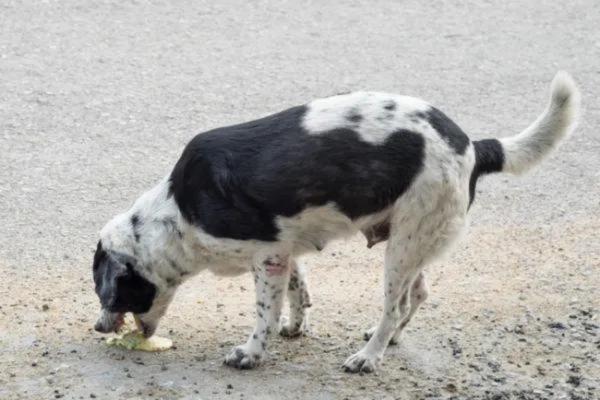
Control of food intake is possible thanks to the interaction of gastrointestinal, nervous, and environmental factors that work together to maintain energy levels and body weight in animals. However, when an imbalance of these control mechanisms occurs, changes in food intake occur, such as polyphagia.
The following AnimalWised article explains what is polyphagia in dogs, its symptoms, what causes it, and how it can be treated.
What is polyphagia in dogs?
Polyphagia in dogs is the medical term for an excessive appetite or overfeeding. A dog with polyphagia has an abnormal and insatiable appetite. Food intake is controlled by the interaction of several factors, such as:
- Gastrointestinal factors
- Nervous factors
- Environmental factors
In the event one or more of these factors is out of balance, a feeding compulsion will develop, causing the dog to eat more than usual. In general, you should always consult your veterinarian as soon as you notice a change in your dog's eating behavior.
If your dog is constantly begging for food and seems hungry even after feeding, you should see a veterinarian because excessive appetite may be a symptom of a serious underlying condition. An increase in hunger may also be accompanied by an increase in thirst. Despite the hunger, your dog may gain or lose weight.
Some pet owners “intuitively” ration their dog's food in this situation. However, this practice can be problematic if the ration offered does not match the amount of food a dog needs based on its age, breed or size, and activity level. Feeding your dog too much or too little can have certain health consequences.
Whenever you have doubts about the amount of food you should give your dog, do not hesitate to consult your trusted veterinarian. Also, remember that energy needs may vary over time due to various factors such as age, activity level, outside temperature, pregnancy or lactation, etc. For this reason, it is important that you consult your veterinarian regularly to optimize your pet's diet.
Remember that there are many factors that can trigger your dog's “obsession” with food. These factors can be related to either physical or psychological problems. This is especially the case if your dog is also obsessed with human food. To rule out other factors, please read our article my dog is obsessed with food.

Types of polyphagia in dogs
As already mentioned, polyphagia in dogs always manifests itself in the same way: by eating excessive amounts. However, for better understanding, we can divide it into three categories:
- Pathological polyphagia: this is the polyphagia that occurs in diseases such as diabetes mellitus, hyperadrenocorticism, exocrine pancreatic insufficiency, insulinoma, gastrointestinal parasites or neurological pathologies.
- Physiologic polyphagia: It occurs in certain physiologic situations to meet the increased energy needs of the body, such as during growth, pregnancy, or lactation, and in other nonpathological situations, such as increased physical activity or low ambient temperature.
- Iatrogenic polyphagia: it is caused by improper feeding of our pets or by pharmacological treatment that causes polyphagia as a side effect.
Some authors also classify polyphagia as follows:
- Primary polyphagia: it is the consequence of a pathology affecting the central nervous system, especially the satiety center in the hypothalamus.
- Secondary polyphagia: It is caused by non-neurological factors.
As we mentioned earlier, dogs may need more food to meet increased energy needs in certain situations, such as pregnancy. If you want to know more about what food to give your pregnant dog, do not miss this article on what to feed a pregnant dog?
Causes of polyphagia in dogs
As we explained in the previous section, polyphagia in dogs can have pathological, physiological, or iatrogenic causes. Below, we explain in more detail each of the causes that may lead to this clinical sign in dogs:
- Neurological: These include changes that affect the center of satiety located in the hypothalamus, such as hypothalamic tumors, head injuries, and inflammatory or infectious processes at the level of the central nervous system.
- Endocrine disorders: These include acromegaly, diabetes mellitus, Cushing's syndrome (or hyperadrenocorticism), or insulinomas. It also occurs with hyperthyroidism, although it is much more common in cats than in dogs.
- Causes related to nutrient loss: as in exocrine pancreatic insufficiency, massive intestinal parasite infestation or intestinal pathologies such as inflammatory bowel disease.
- Tumors: as neoplastic cells have high energy requirements.
- Physiological: Growth, pregnancy, lactation, cold and intense physical activity. They all have in common that they increase the energy needs of the organism, which in turn increases appetite.
- Behavioral: Boredom, stress or competition for food when several dogs live together. It should be noted that polyphagia is considered normal in some breeds, such as the Labrador Retriever or the Pug.
- Dietary: hypocaloric or low nutrient diets lead to polyphagia because they do not meet the energy needs of the animal. On the other hand, switching to more palatable or palatable feeds also leads to polyphagia.
- Pharmacological: Some drugs such as benzodiazepines, corticosteroids, progestins, antihistamines or anticonvulsants may cause polyphagia as a side effect.
If your dog eats anxiously and seems to have an insatiable hunger, that anxiety may spread to other areas of his life.
Symptoms of polyphagia in dogs
Polyphagia is in itself a clinical sign that may manifest as follows:
- More frequent consumption of food.
- Consumption of a greater amount of food than normal.
- Constantly searching for food at home or on the street.
- Constant requests for food to caregivers or guardians.
- It is also common for dogs to “steal” food from the pantry, garbage, or even eat the food of other pets they live with.
When we notice polyphagia in a dog, it is important to look for other clinical signs that may indicate disease and help support the diagnosis. Some of the signs that may be associated with polyphagia are:
- Increased thirst
- Frequent and increased urination
- Weight loss or gain
- Panting
- Change in behavior
- Vomiting or diarrhea
Vomiting and diarrhea are relatively common in dogs and can be caused by a variety of factors. Read on to learn more about why your dog is vomiting and having diarrhea.

Diagnosis of polyphagia in dogs
Diagnosis of canine polyphagia should focus on the following aspects:
- Nutritional assessment: it is important to know if it is an iatrogenic polyphagia caused by poor nutritional management. It is necessary to examine the type of feed the animal is eating (commercial feed or homemade feed), the quantity and number of feedings per day, and the caloric density or energy content of each feed. For a ration to be effective, it should also meet the animal's nutritional requirements.
- Evaluation of weight changes: Although it may seem contradictory a priori, we must know that polyphagia can be accompanied by both weight gain and weight loss. Usually, neurological, pharmacological, dietary, behavioral and some physiological causes are associated with weight gain. In contrast, some pathological causes such as diabetes mellitus or exocrine pancreatic insufficiency are associated with a decrease in body weight.
- Evaluation of the physiological condition: as we have already explained, there are several physiological situations that lead to an increased energy demand, causing polyphagia. Therefore, to rule out the possibility of physiological polyphagia, it is important to determine if the animal is suffering from other diseases.
- Recognition of other clinical signs: Recognition of other clinical signs by the caregiver or veterinarian will aid in the diagnosis in the case of pathological polyphagia.
- Supplemental testing: After ruling out the causes of physiologic and iatrogenic polyphagia, additional testing may be required to make a definitive diagnosis of the disease causing the polyphagia. Laboratory tests should generally be performed to detect endocrine diseases, coprological tests for digestive parasites, imaging studies (such as X-rays, ultrasound and magnetic resonance imaging), etc.

Prevention of polyphagia in dogs
Before we talk about prevention, we must know that not all cases of polyphagia are preventable. Iatrogenic causes, such as poor diet or drugs, are preventable. However, there are many pathological causes of polyphagia in dogs that cannot be prevented. In this section, we will focus on the main causes of polyphagia that can be avoided with proper preventive measures:
- Adequate diet: a balanced diet, adapted to the needs of the animal, is important to avoid the nutritional causes of polyphagia in dogs. Adjusting the caloric density of the ration in animals with higher energy requirements (such as pregnant or lactating bitches) also prevents the physiological causes of polyphagia.
- Adhere to the vaccination and deworming program: As we mentioned earlier, there are infectious and parasitic causes that can cause polyphagia. For this reason, it is extremely important to adhere to the vaccination and deworming program to prevent the occurrence of polyphagia due to these causes.
- Avoid behavioral changes: Both stress and boredom due to loneliness or lack of physical and mental activity can trigger psychogenic polyphagia in dogs. For this reason, it is important to give our pets the time and attention they need to avoid the occurrence of these types of behavioral changes. Also, if you live with more than one dog, make sure you give each dog the amount of food they need, in separate bowls and, whenever you deem it appropriate, in separate places.
A natural diet is a great way to control your pet's food intake. It usually contains fewer additives and is also more digestible. Overall, this is a healthy and beneficial option that you can monitor yourself. Continue reading our article about a natural diet for dogs, an organic and healthy option.

Treatment of polyphagia in dogs
Depending on the underlying cause of polyphagia in dogs, we can treat it in different ways. This section discusses the treatment of polyphagia in dogs based on the underlying cause:
- Pathological polyphagia: To reverse pathological polyphagia, specific treatment of the underlying disease is required. Depending on the pathology, treatment may be pharmacological, surgical, and/or dietary.
- Physiological polyphagia: Physiological polyphagia occurs in conditions that lead to an increased energy demand of the organism. To prevent it, simply provide a higher energy density ration to meet the animal's needs.
- Iatrogenic polyphagia: When polyphagia is caused by inadequate feeding management, nutritional errors must be corrected by adjusting the amount and composition of the ration to meet the animal's needs. When polyphagia occurs as a side effect of drug administration, it is generally not necessary to interrupt treatment because polyphagia is not a serious side effect. However, it is important to inform the veterinarian who prescribed the treatment of the occurrence of this side effect and, even if an increase in the animal's appetite is noted, not to increase the amount of ration. If the cause of polyphagia is behavioral, the triggering element must be eliminated or corrected through behavioral therapy.
This article is purely informative. AnimalWised does not have the authority to prescribe any veterinary treatment or create a diagnosis. We invite you to take your pet to the veterinarian if they are suffering from any condition or pain.
If you want to read similar articles to Increased Appetite in Dogs - Polyphagia, we recommend you visit our Other health problems category.
- Ettinger, S., Feldman, E. (1997). Chapter 34: Polyphagia In Treatise on Veterinary Internal Medicine: Diseases of the Dog and Cat. Elsevier; 120-123
- Gough, A., Murphy, K. (2015). Polyphagia. In Differential diagnosis in small animal medicine. Wiley Blackwell; 10-11
- Tilley, L., Smith, F. (2011). Blackwell's five-minute veterinary consult: canine and feline . Wiley-Blackwell; 6717-6725